| Biberius Ribera del Duero 2012 (£10). A perfect return to wine drinking after an enforced abstinence. Three and a half weeks in Ecuador was the holiday of a lifetime but the choice of wine left a lot to be desired. There's something very soothing about the chink of 2 Riedel glasses and the echoing ring that tells you wine is back on the agenda. This big, bold 100% Tempranillo (the grape that makes most of Spain's favourite reds) has good smooth tannin, delicious blackberry and baked fruit, hints of vanilla along with juicy acidity, chocolate or mocha notes and a whacking 14% alcohol. It's a simple but bold, drinkable wine with bags of dark fruit which pairs well with red meat, strong cheese and Friday night. Mr Purple Teeth rated it as "very good" on the first sip & was further impressed when I told him it's price & where I'd bought it. It was equally good on the second night (sealed overnight with a vacu-vin) and I'm sure would have been fine on the third night, but it was never going to last that long at Chateau Purple Teeth. Available from my friend Jo at Perfect Friday Wine, it's powerful punch is worth seeking out. She delivers locally in the Maidenhead area, and you can order online. It was just a big hit as her Spanish Verdejo which I drank last month. Cheers! PS It's lucky that we enjoyed some wine on our return as Mr Purple Teeth was prescribed antibiotics and told not to drink for 9 days shortly after. Luckily he enjoyed 2 great wines before this insult, and I'm trying not to | |
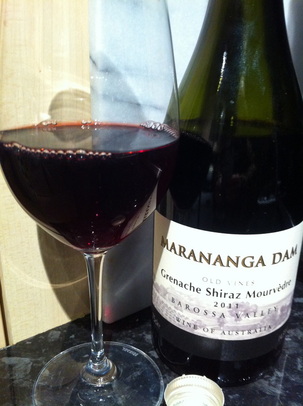 Marananga Dam GSM 2011 (14.5% abv) £14.99 M&S Marananga Dam GSM 2011 (14.5% abv) £14.99 M&S The home of GSM is the Rhône Valley, in France. There the blend of Grenache, Syrah & Mourvèdre has been elevated from wine to art form, and a centuries old tradition culminating in some iconic blends from appellations such as Chateauneuf-du-Pape. As winner of the Rhône prize, and a case of Rhône wines, it's a brave man who brings me an Australian GSM. However, this one is from the Barossa Valley, the Southern Hemisphere's spiritual home for the Syrah grape, where it creates intensely powerful Shiraz wines from seriously old vines, so I hoped for great things. The Marks and Spencer Marananga Dam GSM 2011 (14.5% abv) is £14.99 making it a lot pricier than the £6.99 Spanish M&S GSM we reviewed last February. At twice the price, could it be twice as good? I guess that depends on your priorities. If you're having a bottle to quaff with some pasta, the Spanish version will do, but if you're looking for something with a lot more concentration to savour, then it may be worth a splurge on the Australian version. I'll be reviewing a number of French GSMs at this price point over the coming months. Let's see whether it's original and best. 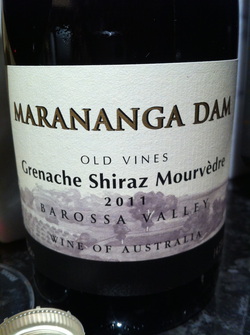 Did I mention the screwcap? Did I mention the screwcap? Our M&S wine had an instantly appealing nose - a smell that you'd happily climb inside. It was not quite as full bodied as Mr Purple Teeth hoped. Still, one can't drink thick stuff every night and it was pretty huge when paired with one of my favourite M&S products, Cornish Cruncher Vintage Cheddar... The first sensation I noted was lovely mouthwatering acidity with the final sensation being a long red fruit sensation, almost with a hint of jammy sweetness. In short, this is right up the Purple Teeth street. Well done that man! Of course, it's no surprise given the 50 year old vines, which bring full fruit ripe intensity and concentration. The baking Barossa sunshine helps with ripeness, the blend of grape varieties gives blackberry, plum, black cherry with savoury notes, while the 18 months in French oak barrels add spicy black pepper and mocha hints. It's by no means got the complexity of a top Rhône wine, nor is it a Barrossa blockbuster Shiraz, but, if you love full bodied fruit forward wines with some depth, chances are this one will delight you. If you regularly drink Californian Old Vines Zinfandel and are looking for a change, you'll find this one delivers or you. I'd love to hear what you think of this wine, the Spanish GSM from M&S, or indeed any GSM blends you've tasted. Feel free to share photos of your favourites on our Facebook page. And if a different Marks and Spencer's wine floats your boat, we'd love to hear about it. Cheers! Quito. A mythical capital city of colonial architecture and altitude . Ecuador's capital is more famous for height than haute cuisine and the local booze is weak Pilsener style beer or fiery aguardiente - the local fire water. So after a few days here, we were craving a glass of wine worth it's price tag and a menu that didn't include Guinea Pig... Consulting The Rough Guide, we pinned our hopes on Zazu. It's also the Trip Advisor top rated restaurant in town. It offered none of the $2.50 set menus found around the Old Town, but as we are celebrating our wedding anniversary on this trip, we decided to go for it. Zazu is based in the new town, and claims to be one of the best restaurants in Ecuador. Phoning at 6pm on a Tuesday night we secured a table for 7.30, a wise move as the place filled up and tables were turned. We'd heard that the Peruvian head chef made the best ceviche so we had to start with that. The Sea Bass marinated in lime juice, red onion & chilli was a great start to the meal, zingy and packed with flavour. We also shared some other appetisers as we'd missed lunch, the Stone Crab cakes were fresh and meaty with no potato filler and the Suckling Pig Tacitos were salty and crispy parcels packed with flavour. The wine list was extensive and mainly South American, as you'd expect. To pair with the whole meal, we needed a white and after some consideration I opted for the Chardonnay by Catena Zapata.the first non-European to win winemaker of the year, Catena's Mendoza vineyards are among the best in Argentina and at $52 the wine was a reasonable price compared to $48 for a basic Concha y Toro wine in the more central areas. The wine was a great match for the exotic food flavours including my rather fusion style main course of Pistachio Encrusted Ahi Tuna served with wasabi flavoured mash. Full of tropical fruit such as pineapple and nectarine, there was also a well judged oak influence creating some vanilla notes and the full body and acidity were in great balance. After so many flavours we opted for dessert wine as a replacement for dessert. Once again we chose Catena, this time the 2008 Semillon Doux which was just sweet enough with zesty lime and acacia honey flavours developing orange marmalade. With tax and service the whole meal came to around $150 including lots of sparkling water and all the wine. That's eye-wateringly expensive for your average Ecuadorian but business seemed to be booming. We'd certainly recommend a visit if you're in that part of the world. Cheers! PS apologies for any typing or formatting irregularities in this post as it's been composed entirely using my phone... I love trying new wines. But it gets expensive. And sometimes it's good to share the costs of experimentation with a like-minded group, especially if you don't know if you're going to like it. Luckily enough, I'm part of a local wine group that meets monthly. It's a great way for me to continue my wine education, as we take it in turns to explore regions or varietals and share our knowledge. Our April session featured wine from Lebanon. It's certainly not a country you can arrange a tasting for by popping into your local supermarket, but a country with a rich tradition in wine even if we're more apt to think of Beirut and bombings, or Human League songs when Lebanon comes to mind. But Lebanon, on the Eastern shores of the Mediterranean, produces around 7 million bottles of wine a year, most of it from the Bekaa Valley. Around 2 million of those bottles come to the UK. But is it any good? Should you be seeking it out? 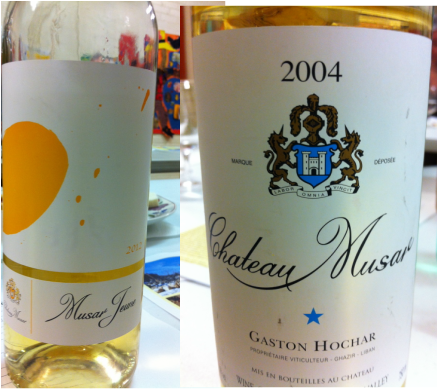 Our hosts for this month were keen enthusiasts of Lebanese wine and had been drinking it for many years, pretty much since Chateau Musar (one of the most prominent wine labels in the Lebanon) first hit the UK with a fanfare of plaudits back in 1979 at the Bristol Wine Fair. They explained that the Bekaa valley is a high plain where most vineyards are planted at between 1000 and 1200 metres, making it similar to Mendoza in Argentina. The summers are hot and dry, but night-times are much cooler because of the altitude. There's clay and limestone soils with gravel and rich terra rossa, so given there's a good water supply from snow melting from the high mountains aside the valley, it sounds like fairly ideal for production of wine from local and international grape varieties. As is customary, we started with white wines. Our first wine was the Musar Jeune 2012 blend of Viognier, Vermentino and Chardonnay, a rather unusual blend which is £9.95 retail and 13.5% abv. It was very drinkable with a candied lemon nose, honeysuckle and pear on the palate, full bodied with a sherbet finish. Musar Jeune is a kind of "diffusion label" of Chateau Musar. Designed for drinking young, and by young wine drinkers the wines are fresh, fruity and have no contact with oak. Compared with the Chateau Musar white from 2004, it's a lot more accessible. Made from indigenous grapes such as Merwah and Obeideh it's extremely rich and intense. Full bodied with almost a nose of boot polish, this was definitely too exotic for me. It's supplied in the UK by Majestic, who describe it thus: "Deep golden hues from a glass that exudes baked apple, almond, brioche, apricot and vanillin aromas. A buttery, rich, honey textured and wine with vanilla, butterscotch, roasted stonefruit and spice." This certainly wasn't my impression of the £18 wine. It seemed like licking an oak barrel and had hints of wet wool. Very odd and not one I'll rush to drink again. Next came the Ixsir Grande Reserva white 2011 (13% abv, £21). Again, an unusual blending of Viognier, Sauvignon Blanc and Chardonnay. A blend like that makes me think they are trying to please everyone. The danger is, pleasing no-one. French oak has been used, and this dominates the perfumed character of the 60% Viognier and the aromatic Sauvignon, producing a kind of "mushy pea" note on the nose. Our panel decided the best description was "liquid falafel", so if you're trying to pair a wine for a chick-pea loving friend, this might be it. But I'd rather have 2 bottles of the Musar Jeune. Moving on to Rosé, we sampled Chateau Ksara, Sunset 2012 (13.5%, £10.95). Ksara is the oldest winery in Lebanon with a 150 years of winemaking. It was a very fruity and very dry rosé made from 60% Cabernet Franc and 40% Syrah, so a bit heftier than some rosés with spicy strawberry and red berry notes and good, bright acidity, it would make an interesting accompaniment to sushi. And then it was time for the reds. Chateau Ka 2011 (14%, £12) is a blend of Cabernet Sauvignon, Merlot and Syrah, it's mid-bodied and savoury with plenty of lightening herbaceous notes on top of the fruit. I gave it two ticks on the vening. I think that means I liked it a lot! Another 2 ticks when to the most widely available of the wines we tasted. The Clos St Alphonse red from Chateau Ksara 2012 (13% around £10) is sold by Marks and Spencers, and if you're inspired to try a Lebanese wine to "visit" a new country, then this is a solid place to start. 19 year old vines produce a blend of Cabernet Franc, Cabernet Sauvignon and Syrah, making a good value red. And then it was time for the Musars. Chateau Musar was established in 1930 by Gaston Hochar at the tender age of 20. His inspiration was the 6000 year winemaking history of Lebanon’s Bekaa Valley and also his time in Bordeaux. In 1959, he stepped aside for his sons Serge and Ronald. The wines have been compared to Bordeaux, Rhone and Burgundy, but they're actually unique. It's been tough going to keep these wines going. In 1989 both the winery and the Hochar family home were hit by shelling in the Civil War. The cellars were even used briefly as bomb shelters to help local people. That's a lot of story for a wine. We started with the Hochar Pere et Fils, the 2nd wine of the Chateau (13%, £12). This 2008 is a blend of Cinsault, Carignan, Cabernet Sauvignon and Grenache is aged in French oak for 9 month, creating a rich, spicy wine with plum and cherries, but I found it very acidic with some leathery and liquorice notes and a smoky, slightly oxidised smell. It's similar to a good old-fashioned Reserva Rioja. Musar was the first Lebanese winery to be certified as organic, and wines are made with the minimum of sulphur and are not fined or filtered so benefit from decanting.  Chateau Musar has been described by many as one of the great wines of the world. It's iconic and quite intense. The Chateau Musar 2005 (14%, £20) and 1999 (14%, £28) are made from Cinsault, Carignan and Cabernet Sauvignon. The Wine Society claims the 2005 will go down as one of the greatest vintages while the 1999 features in "1001 Wines To Try Before You Die" (link below). Good dark fruits, lots of leathery notes and spice along with plenty of acidity. For the serious wine lover, it's definitely worth trying Musar at least once but you'll want to drink it along with a nice steak rather than on its own. If you've drunk Lebanese wine and enjoyed it, or perhaps even visited the Lebanon and it's wineries, why not share your views or photos on our Facebook page? Hopefully we've inspired you to try something new. At least there's no shelling at your local M&S this weekend. And if you'd like help setting up a wine club, Purple Teeth would be happy to come and present some wines for you, to get you started. Cheers!
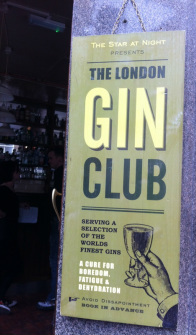 Gin. One of the few forms of alcohol that never really floated my boat. Being Scottish, I used to believe my distaste was because G&T was as quintessentially English as The Boat Race, Henley Regatta or cucumber sandwiches. Now that i've lived in Royal Berkshire for over 10 years, however, I've looked for other reasons. Perhaps it's tonic I don't like? There's too much wine to enjoy? Vodka is purer? I need to support the Scottish Whisky Industry. Studying for my Wine and Spirit Education Trust exams, I had no choice but to sample gin and taste it analytically. Mixing the pure spirit with 50% water lent some weight to the argument that it's the mixture with tonic which exacerbated the problem. But still. There was something about distilled drinks flavoured with juniper which had limited appeal for me. Until now... It was with some surprise that on Good Friday, I found myself at The London Gin Club in Soho's Great Chapel Street. Some good friends had decided to treat gin-loving Mr Purple Teeth to an early birthday treat. 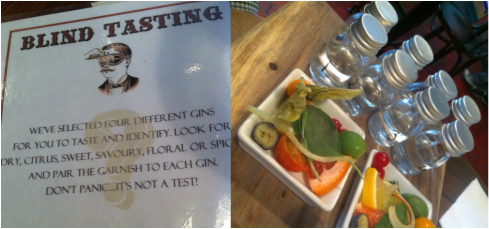 The "blind" gins are served with a selection of garnishes. You decide what goes best. The "blind" gins are served with a selection of garnishes. You decide what goes best. A small table-service bar open from 6-11pm Tuesday to Saturday, booking a table in advance is highly recommended. Then you can enjoy a relaxed time either sampling a gin you know and love, experimenting with blind tasting or trying one of the gin tasting menus, to discover new favourites. You can also try a variety of premium tonics. The standard tonic offered is Fevertree. If you can specify, booking a table in the basement will add a little more of that vintage "gin joint" appeal. 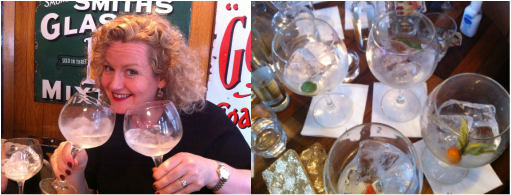 Luckily I guessed a couple of the gins correctly with the right garnish Luckily I guessed a couple of the gins correctly with the right garnish We opted for a blind tasting, and as you can see, I found a couple of gins I actually quite liked. Mr Purple Teeth and I preferred to add just a splash of tonic and a low amount of ice rather than the icebergs and half bottle of tonic per gin that was recommended. Gin Mare, a Mediterranean inspired gin from Costa Dorada Spain was an interesting choice with rosemary, thyme, and many of the usual "botanicals" that make gin gin, such as juniper, bitter orange, cardamom and coriander, enjoyed by all. Surprisingly, I enjoyed the Navy Strength (57%) the most. This did nothing to change my reputation as a hardened drinker. I did somewhat make up for this by being able to identify each gin from blindly sniffing the empty bottles. 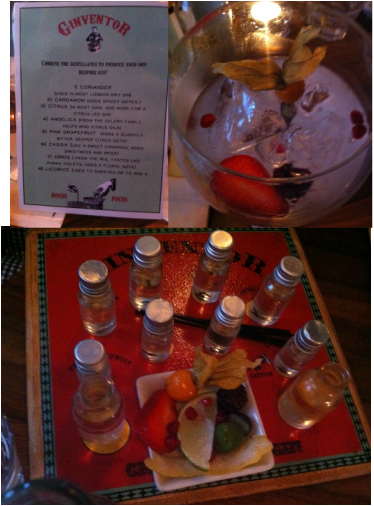 After this success, we decided to go all out and try to blend our own gin. The Ginventor is a neat idea designed for 2 to enjoy. You get 25ml of Juniper base and smaller amounts of 6 botanical distillates of cardamom, coriander, citrus, angelica, pink grapefruit, licorice, cassia and orris, giving you the basic components to create either a citrus, dry, spicy, smooth, earthy or sweet gin. A selection of garnishes are also provided. This can really help you figure out what kind of gin you prefer, what components you enjoy and help you select and enjoy exactly the right drink from the 130 plus gins on offer behind the bar. All 4 of us had quite different preferences, and of course, I invented the very finest selection, which, if bottled, might just have turned me into a gin lover. It was a fun evening, and I learned that I don't hate gin after all. I'm not sure I'll convert from wine, and I'll still enjoy a dry sherry as an aperitif, but, if any Purple Teeth readers fancy a gin tasting party, I'm now far more equipped to help you out.
|
Purple TeethMy name's Heather and I've been enjoying wine for over 20 years. I'm the 2013 winner of the Wine and Spirit Education Trust Rhone prize for oustanding students at the advanced level. |

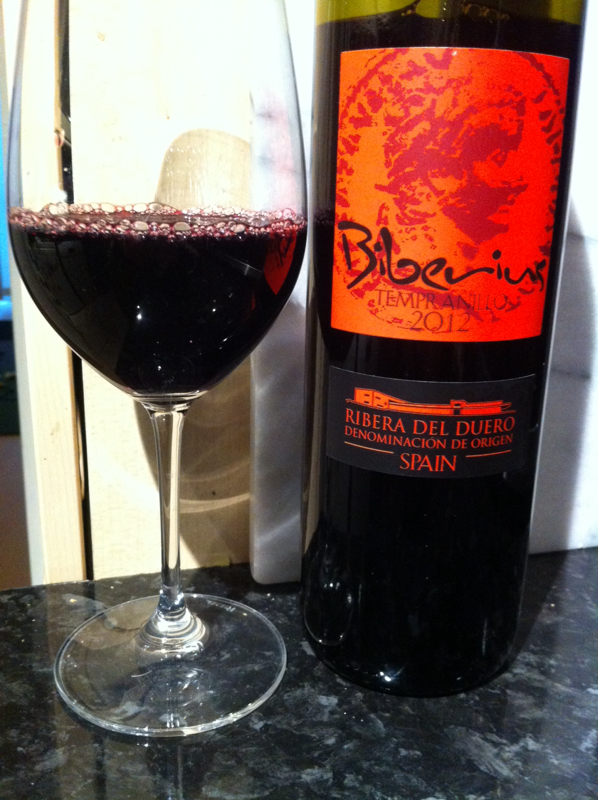
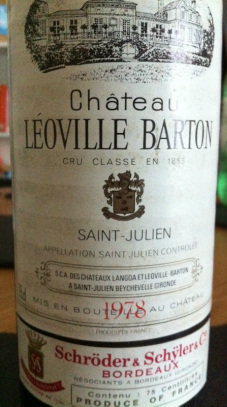
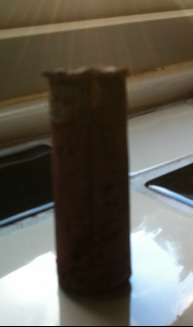
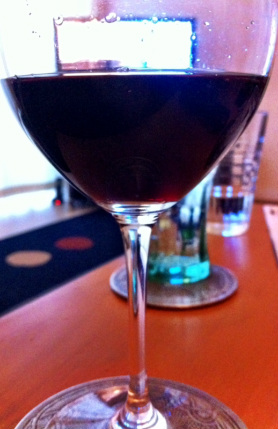
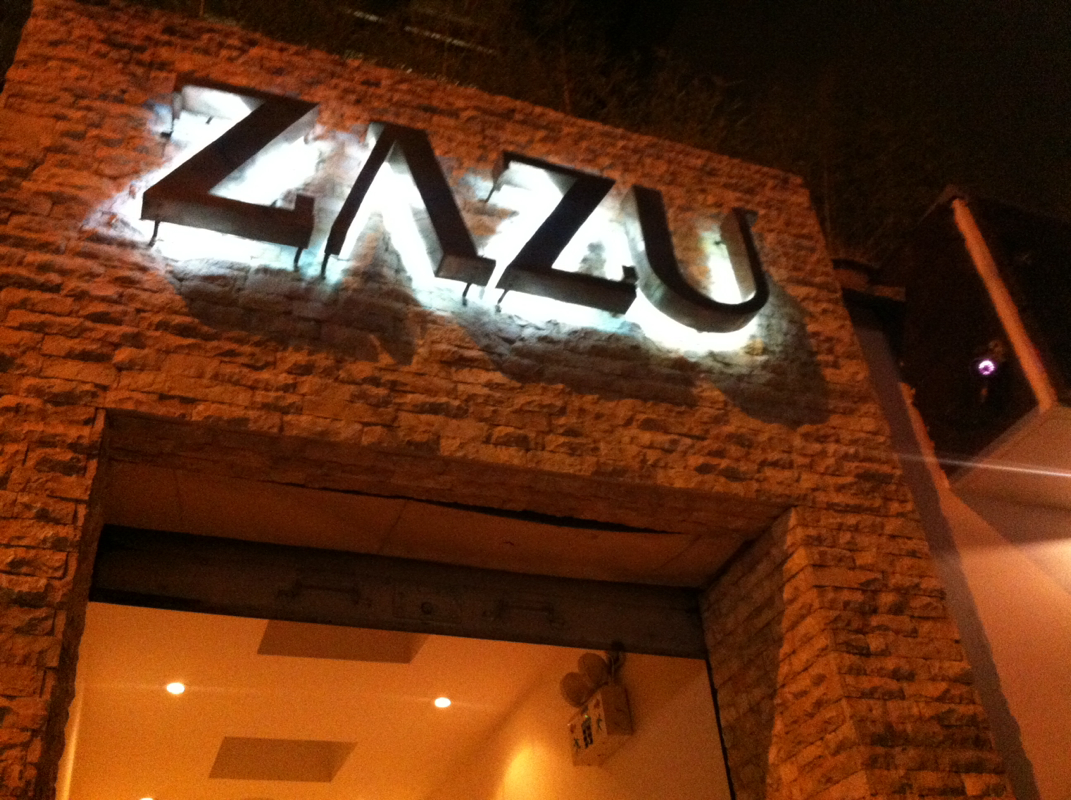
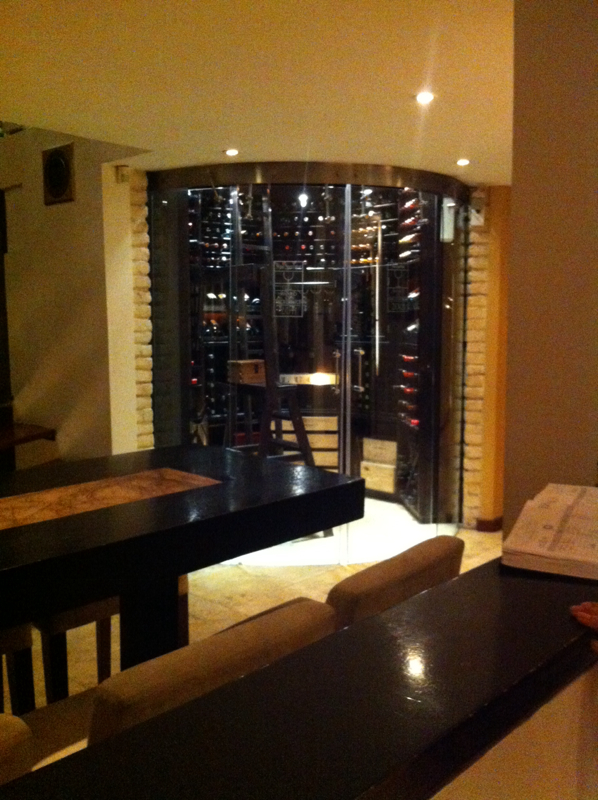
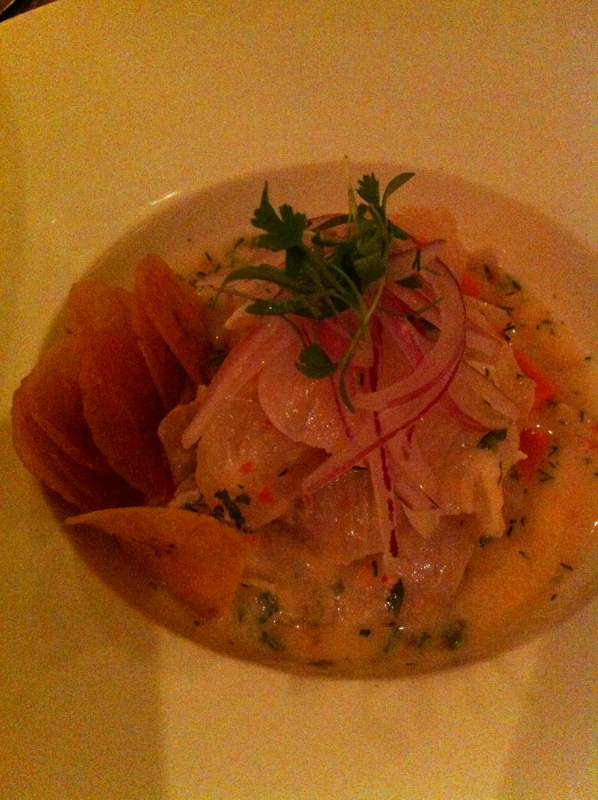
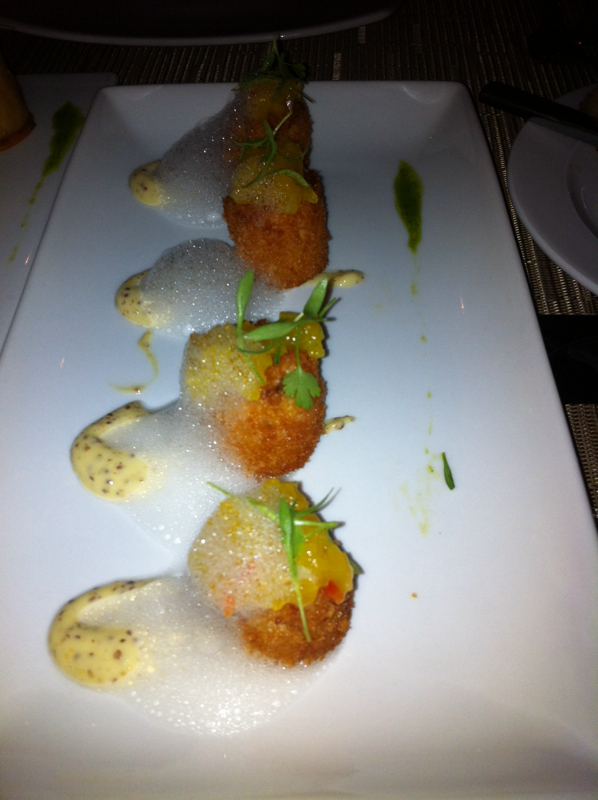
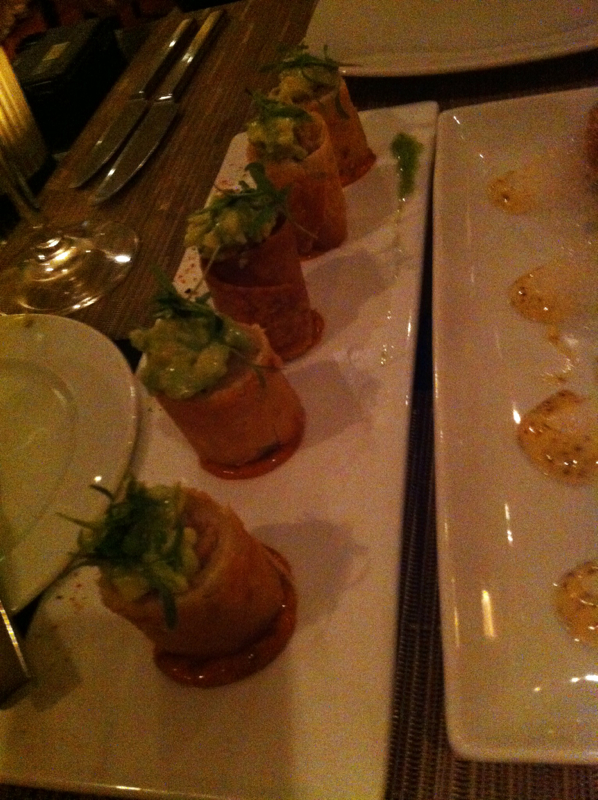
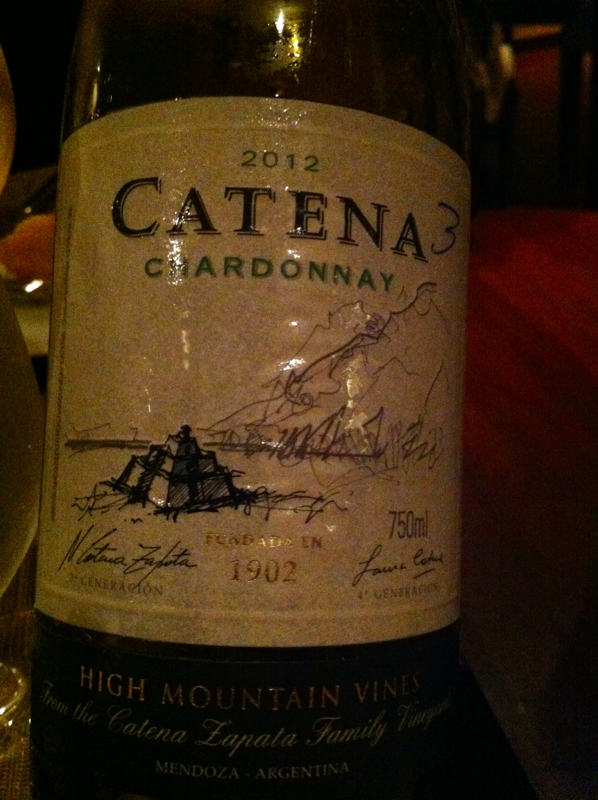
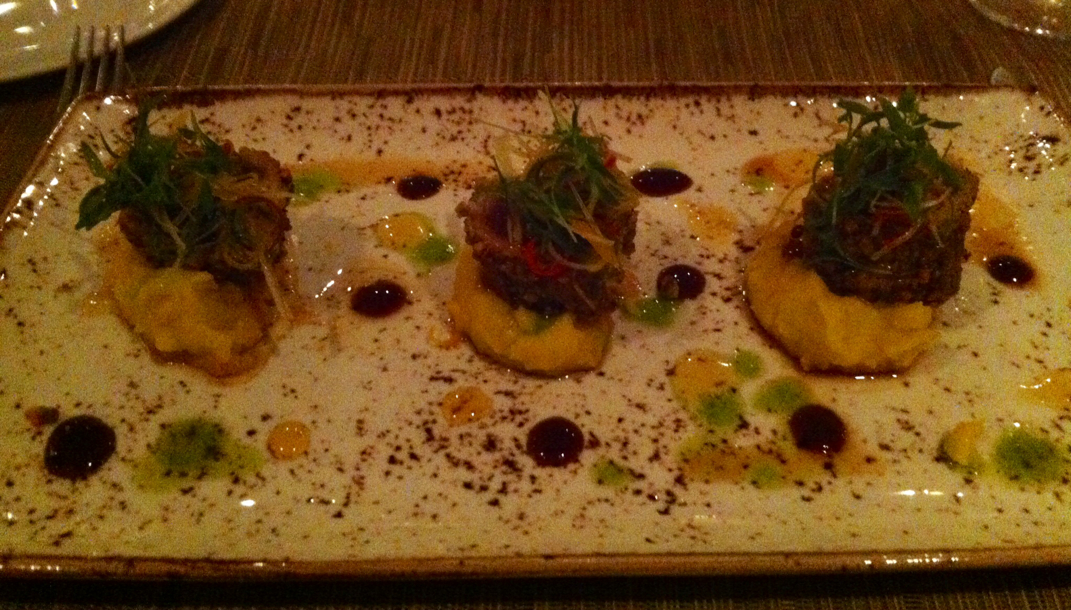
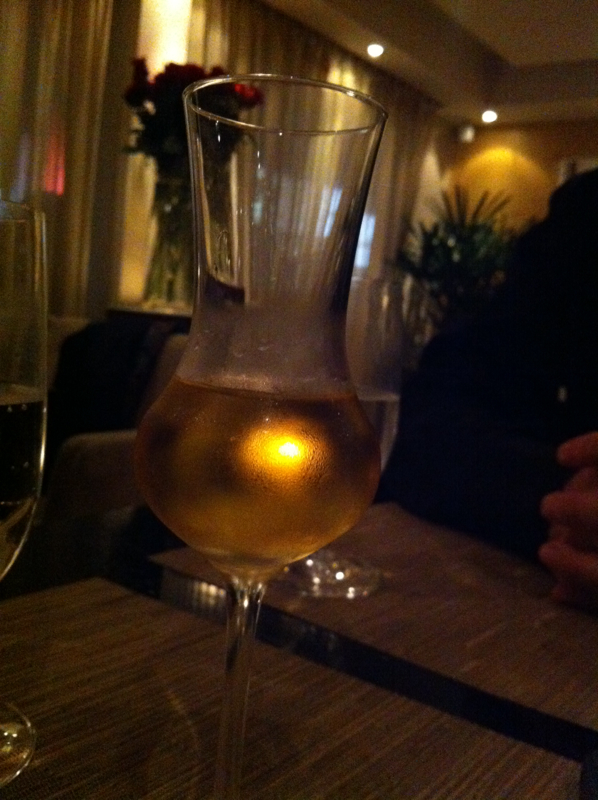
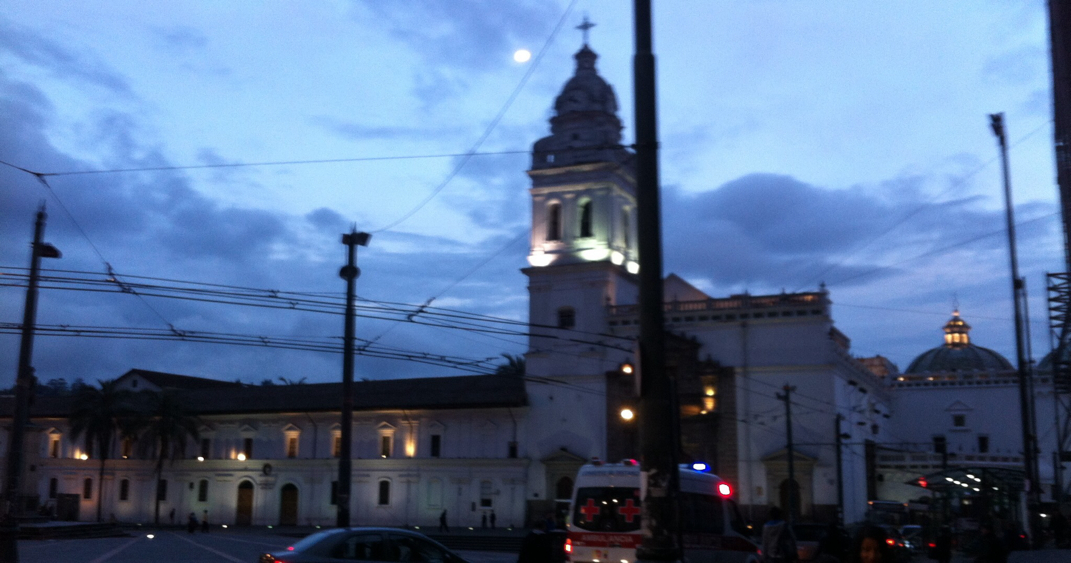

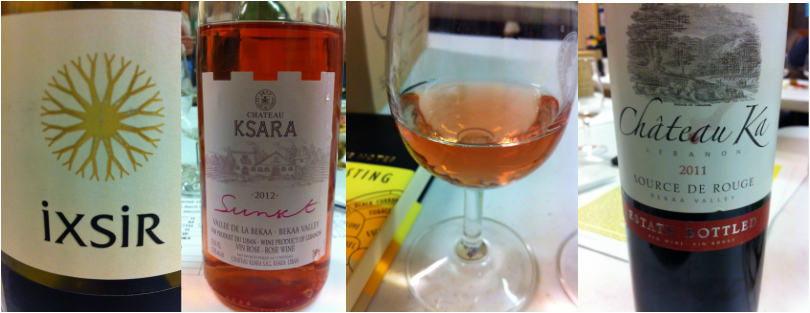


 RSS Feed
RSS Feed
